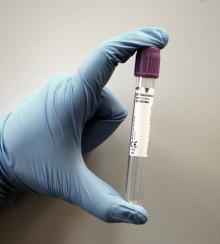Botox and CGRP – and the Future of Migraine Treatment
A new study about Botox and CGRP confirms some of our suspicions, and may point the way to future migraine research and treatment.
Although it’s really started making headlines over the past year or two, the study of CGRP in migraine has been heating up over the past 20 years. CGRP stands for calcitonin gene-related peptide neurotransmitter. These neurotransmitters are especially involved in the communication of pain messages in the body (see The Secret of CGRP).
Early on, researchers began to suspect that CGRP levels rose during a migraine attack – so far nothing surprising.
However, researchers next began to discover that CGRP levels tended to be higher in migraine patients all the time, although levels seemed to drop with triptan treatments.
 A study in 2013 showed that women with various types of migraine and cluster had elevated levels of CGRP in their blood (between attacks). Among those with migraine, those with chronic migraine had the highest levels – and among those with chronic migraine, migraine with aura showed the highest levels of all.
A study in 2013 showed that women with various types of migraine and cluster had elevated levels of CGRP in their blood (between attacks). Among those with migraine, those with chronic migraine had the highest levels – and among those with chronic migraine, migraine with aura showed the highest levels of all.
That finally brings us to the research related to Botox. As many of you know, Botox treatment works well for some people, and not for others. Why?
Last year we talked about a study which showed that people with high levels of CGRP were far more likely to benefit from Botox (onabotulinumtoxin type A) treatments.
Last month, another study confirmed the same thing. Once again, patients with higher levels of CGRP were more likely to respond well to treatment.
But a month after the Botox treatment, levels of responders dropped – although the levels in nonresponders did not.
We are left with a lot of unanswered questions – but those questions could drive migraine research in the direction it needs to go.
Why the different levels of CGRP? Exactly what role do CGRP levels play in migraine? Could this point us to an underlying cause or disorder?
Perhaps more importantly – why the differences?
Over the past few years, research has shown us again and again and again – not all migraine disease is the same. There are “different migraines”, with different treatments, different symptoms, and different neurological manifestations.
And yet we still so often talk about “migraine” as if it’s one thing and one thing only.
Those in cancer research and treatment are learning this the hard way as well – not all cancer is the same, not all cancer is equally dangerous, and not all cancer should be treated in the same way.
Migraine research is going – and must go – the same direction.
Imagine going to the lab for tests – and then being diagnosed with a specific type of migraine – and then getting treatment for that type specifically. Your chances of excellent treatment will go way up.
For now, we have an important way forward for research into CGRP levels, and for Botox treatment. In the future – something much bigger and better.
